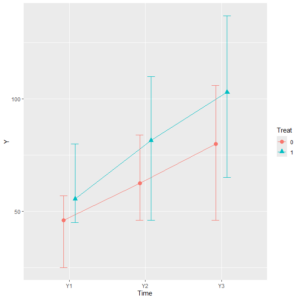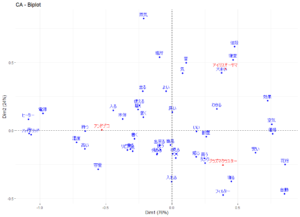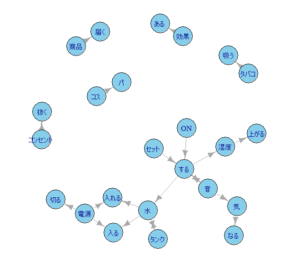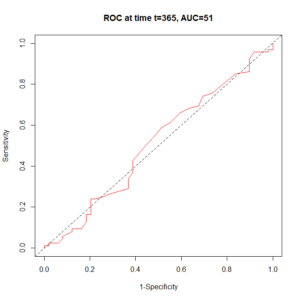バギングというアンサンブル学習を R でやってみる。
ランダムフォレストとバギングの違い
ランダムフォレストとバギングの違いは、以下の記事を参照。

バギングのための R パッケージの準備
adabagパッケージをインストールする。
install.packages("adabag")インストール後、呼び出しておく。
library(adabag)バギングためのデータの準備
例題のデータを準備する。
データはirisを使う。
irisは150行のデータ。一部を学習データにする。
150を50ずつ3つに分けて、それぞれ50個から35個をランダムに取りだして、105個のsubという数列を作る。subに一致する行番号のデータを学習データにする。
いつも同じ結果ができるようにseedを決めておく。
set.seed(17)
sub <- c(sample(1:50, 35), sample(51:100, 35), sample(101:150, 35))バギングの解析例
irisのSpeciesを分類する識別器をbaggingで求める。mfinalは分類木の数。デフォルトは100。
set.seed(17)
iris.bagging<-bagging(Species ~ ., data=iris[sub,], mfinal=10)
iris.bagging分類木は以下の10個が作られた。
> iris.bagging$trees
1
n= 105
node), split, n, loss, yval, (yprob)
* denotes terminal node
1) root 105 66 versicolor (0.3238095 0.3714286 0.3047619)
2) Petal.Length< 2.5 34 0 setosa (1.0000000 0.0000000 0.0000000) *
3) Petal.Length>=2.5 71 32 versicolor (0.0000000 0.5492958 0.4507042)
6) Petal.Width< 1.7 40 1 versicolor (0.0000000 0.9750000 0.0250000) *
7) Petal.Width>=1.7 31 0 virginica (0.0000000 0.0000000 1.0000000) *
2
n= 105
node), split, n, loss, yval, (yprob)
* denotes terminal node
1) root 105 67 setosa (0.36190476 0.29523810 0.34285714)
2) Petal.Length< 2.5 38 0 setosa (1.00000000 0.00000000 0.00000000) *
3) Petal.Length>=2.5 67 31 virginica (0.00000000 0.46268657 0.53731343)
6) Petal.Width< 1.75 34 3 versicolor (0.00000000 0.91176471 0.08823529) *
7) Petal.Width>=1.75 33 0 virginica (0.00000000 0.00000000 1.00000000) *
3
n= 105
node), split, n, loss, yval, (yprob)
* denotes terminal node
1) root 105 59 versicolor (0.20000000 0.43809524 0.36190476)
2) Petal.Width< 1.7 71 25 versicolor (0.29577465 0.64788732 0.05633803)
4) Petal.Length< 2.5 21 0 setosa (1.00000000 0.00000000 0.00000000) *
5) Petal.Length>=2.5 50 4 versicolor (0.00000000 0.92000000 0.08000000) *
3) Petal.Width>=1.7 34 0 virginica (0.00000000 0.00000000 1.00000000) *
4
n= 105
node), split, n, loss, yval, (yprob)
* denotes terminal node
1) root 105 63 setosa (0.4000000 0.2761905 0.3238095)
2) Petal.Length< 2.6 42 0 setosa (1.0000000 0.0000000 0.0000000) *
3) Petal.Length>=2.6 63 29 virginica (0.0000000 0.4603175 0.5396825)
6) Petal.Width< 1.75 33 4 versicolor (0.0000000 0.8787879 0.1212121)
12) Petal.Length< 4.95 26 0 versicolor (0.0000000 1.0000000 0.0000000) *
13) Petal.Length>=4.95 7 3 virginica (0.0000000 0.4285714 0.5714286) *
7) Petal.Width>=1.75 30 0 virginica (0.0000000 0.0000000 1.0000000) *
5
n= 105
node), split, n, loss, yval, (yprob)
* denotes terminal node
1) root 105 68 setosa (0.35238095 0.31428571 0.33333333)
2) Petal.Length< 2.5 37 0 setosa (1.00000000 0.00000000 0.00000000) *
3) Petal.Length>=2.5 68 33 virginica (0.00000000 0.48529412 0.51470588)
6) Petal.Length< 4.8 31 0 versicolor (0.00000000 1.00000000 0.00000000) *
7) Petal.Length>=4.8 37 2 virginica (0.00000000 0.05405405 0.94594595) *
6
n= 105
node), split, n, loss, yval, (yprob)
* denotes terminal node
1) root 105 70 setosa (0.33333333 0.33333333 0.33333333)
2) Petal.Length< 2.6 35 0 setosa (1.00000000 0.00000000 0.00000000) *
3) Petal.Length>=2.6 70 35 versicolor (0.00000000 0.50000000 0.50000000)
6) Petal.Length< 4.75 34 0 versicolor (0.00000000 1.00000000 0.00000000) *
7) Petal.Length>=4.75 36 1 virginica (0.00000000 0.02777778 0.97222222) *
7
n= 105
node), split, n, loss, yval, (yprob)
* denotes terminal node
1) root 105 60 versicolor (0.25714286 0.42857143 0.31428571)
2) Petal.Length< 2.6 27 0 setosa (1.00000000 0.00000000 0.00000000) *
3) Petal.Length>=2.6 78 33 versicolor (0.00000000 0.57692308 0.42307692)
6) Petal.Length< 4.75 42 0 versicolor (0.00000000 1.00000000 0.00000000) *
7) Petal.Length>=4.75 36 3 virginica (0.00000000 0.08333333 0.91666667) *
8
n= 105
node), split, n, loss, yval, (yprob)
* denotes terminal node
1) root 105 66 setosa (0.37142857 0.30476190 0.32380952)
2) Petal.Length< 2.6 39 0 setosa (1.00000000 0.00000000 0.00000000) *
3) Petal.Length>=2.6 66 32 virginica (0.00000000 0.48484848 0.51515152)
6) Petal.Length< 4.75 31 0 versicolor (0.00000000 1.00000000 0.00000000) *
7) Petal.Length>=4.75 35 1 virginica (0.00000000 0.02857143 0.97142857) *
9
n= 105
node), split, n, loss, yval, (yprob)
* denotes terminal node
1) root 105 59 versicolor (0.22857143 0.43809524 0.33333333)
2) Petal.Width< 1.7 71 25 versicolor (0.33802817 0.64788732 0.01408451)
4) Petal.Length< 2.6 24 0 setosa (1.00000000 0.00000000 0.00000000) *
5) Petal.Length>=2.6 47 1 versicolor (0.00000000 0.97872340 0.02127660) *
3) Petal.Width>=1.7 34 0 virginica (0.00000000 0.00000000 1.00000000) *
10
n= 105
node), split, n, loss, yval, (yprob)
* denotes terminal node
1) root 105 67 setosa (0.3619048 0.3333333 0.3047619)
2) Petal.Length< 2.6 38 0 setosa (1.0000000 0.0000000 0.0000000) *
3) Petal.Length>=2.6 67 32 versicolor (0.0000000 0.5223881 0.4776119)
6) Petal.Width< 1.7 35 0 versicolor (0.0000000 1.0000000 0.0000000) *
7) Petal.Width>=1.7 32 0 virginica (0.0000000 0.0000000 1.0000000) *
分類木の決定は Plurality Vote(多数代表制)で決める。
The majority vote (the most often predicted class) で併合する。
adabag: An R Package for Classification with Boosting and Bagging (PDF)
テストデータ(-subで行番号を指定)で予測性能を確認する。
predict.bagging()でテストデータでの予測が行える。
iris.predbagging<-predict.bagging(iris.bagging, newdata=iris[-sub,])
iris.predbaggingConfusion tableで誤分類を確認する。
versicolorをvirginicaに1件、virginicaをversicolorに2件、誤分類した。
> iris.predbagging$confusion
Observed Class
Predicted Class setosa versicolor virginica
setosa 15 0 0
versicolor 0 14 2
virginica 0 1 13
誤分類率は0.067(6.7%)と計算された。
> iris.predbagging$error
[1] 0.06666667
まとめ
バギングは、学習セットからブートストラップ法で何度もサンプリングして、分類器をいくつも作り、それを併合してよりよい分類器を作る方法。
Rでは、adabagパッケージのbagging()で実行可能。








コメント